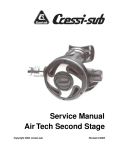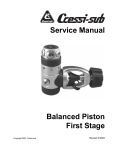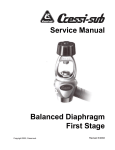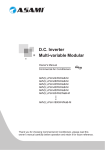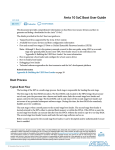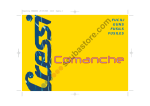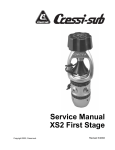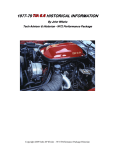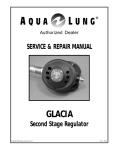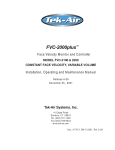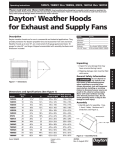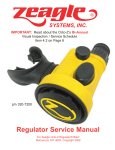Download AirPlusSecondStage767 KBytes
Transcript
Service Manual Air Plus Second Stage Includes XS Series Second Stage Copyright 2002, Cressi-sub Revised 3/2002 ○ ○ ○ ○ ○ ○ ○ 2 Air Plus Second Stage Service Manual Contents BEFORE STARTING ....................................................................................... 3 DISASSEMBLY ................................................................................................ 3 PARTS CLEANING AND LUBRICATION ....................................................... 8 CLEANING METAL PARTS ............................................................................................ 8 CLEANING PLASTIC-ONLY PARTS .............................................................................. 8 LUBRICATION ................................................................................................................ 8 Types of Lubricant ..................................................................................................... 8 O-rings ....................................................................................................................... 9 Threaded parts .......................................................................................................... 9 REASSEMBLY ................................................................................................. 9 ADJUSTING THE SECOND STAGE.............................................................. 13 ADJUSTING THE SECOND STAGE WITHOUT AN IN-LINE ADJUSTMENT TOOL. ... 13 ADJUSTING THE SECOND STAGE WITH AN IN-LINE ADJUSTMENT TOOL. .......... 13 FINAL REASSEMBLY ................................................................................... 14 TABLE 1 - TROUBLESHOOTING ................................................................. 17 TABLE 2 - REQUIRED TOOLS ..................................................................... 17 EXPLODED PARTS DIAGRAM..................................................................... 18 ○ ○ ○ ○ ○ ○ ○ BEFORE STARTING WARNING This manual is not a training document. It is meant to be a guide for experienced technicians who have also received factory training at a Cressi-sanctioned repair seminar. Do not attempt to repair this or any regulator without the proper training. Before starting, Cressi recommends that you read through the entire manual to familiarize yourself with all the required tools and techniques. Use this manual as a guide during the servicing process to avoid missing any critical steps. Make sure the work area is clean and that you work over a cushioned work surface so critical parts do not get damaged. Pay close attention to all warnings and cautions as they will alert you to any potential hazard that may cause damage or injury. Also, pay attention to the notes as they provide important tips and reminders. DISASSEMBLY 1. Using a 9/16” wrench, unscrew the 2nd stage hose from the first stage. Remove the O-ring from the end of the hose. 2. While holding the inlet fitting (27) with a 3/4” (19mm) wrench, unscrew the swivel hose fitting using an 11/16” wrench (see figure 1). Using a brass or plastic O-ring pick, remove the O-ring (30) located inside the hose swivel. Figure 1. Removing the hose. 3 ○ ○ ○ ○ ○ ○ ○ 4 Air Plus Second Stage Service Manual 3. Using side cutters, snip the mouthpiece clamp (12). Pull the mouthpiece (11) off the second stage body (4). 4. Using a Phillips screwdriver, remove the exhaust tee retaining screw (10) as shown in figure 2. 5. To remove the exhaust tee (9), place your thumb on the top corner of the exhaust tee and press downward. Figure 2. Removing the exhaust tee screw 6. Figure 3. Press down on top corner of exhaust tee to remove Remove the exhaust valve (6) by grasping it with your thumb and forefinger and pulling it straight out. 7a. (For the Air Plus second stage only.) Using your fingers, unscrew the front cover retaining ring (1b). Separate the front cover assembly (1a) from the retaining ring. Lift out the diaphragm (3). 7b. (For the XS series second stage only.) Using a small, flat-tipped jewelers screwdriver, pry out the front cover locking tab (5) as shown in figure 4. Using the palm of your hand, unscrew the front cover assembly (1c). Lift out the diaphragm washer (2) and remove the diaphragm (3). Figure 4. Removing the front cover locking tab (XS series only) 8. Using an 6 mm hex wrench, unscrew the port plug (8). Remove the O-ring (7) from the port plug. ○ ○ ○ ○ ○ ○ ○ 9. Using a 3/4” (19mm) wrench, unscrew the inlet fitting (27) from the second stage housing as shown in figure 5. Using a brass or plastic O-ring pick, remove the O-ring (26) located in the face of the inlet fitting. Figure 5. Remove inlet fitting CAUTION Take special care when removing the adjustable orifice so the sealing edge is not damaged. Place the orifice on a cushioned surface while disassembling the remainder of the second stage. Keep it away from the edge of the work bench so it doesn’t fall to the floor and become damaged. 10. Using a medium flat-blade screwdriver, unscrew the adjustable orifice (29) until the threads are disengaged (about five complete turns counterclockwise) as shown in figure 6. Insert a small, wooden or plastic dowel into the inlet fitting against the sealing edge of the adjustable orifice. Press on the orifice and remove it from the inlet fitting (figure 7). Figure 6. Unscrew adjustable orifice to disengage threads Figure 7. Use a dowel to push adjustable orifice out of inlet fitting 5 ○ ○ ○ ○ ○ ○ ○ 6 Air Plus Second Stage Service Manual 11. Remove the adjustable orifice O-ring (28) with a brass or plastic Oring pick. 12. Press on the poppet assembly (23-25) to compress the spring. While keeping the poppet spring compressed, insert a 5.5mm nutdriver through the open port on the right side of the second stage housing and unscrew the locknut (16). After the locknut is removed, slowly release the pressure on the spring. Remove the poppet assembly, spring (22), lever (19), and washer (17) as shown in figure 9. Figure 8. Compress poppet and remove locknut with 5.5mm nut driver 13. Separate the spring from the poppet assembly. Hold the threaded end of the poppet stem (24) and slide the white plastic seat retainer (23) toward the threads and remove it from the poppet stem. Remove the rubber seat (25) from the end of the poppet stem. (See figure 10.) 14. Insert a small flat-bladed screwdriver through the open port on the right side of the second stage housing. Slide the edge of the screwdriver blade into the small slot located in the middle of the venturi channel (18). Gently pry the venturi channel loose and remove with your fingers. (See figure 11.) Figure 9. Remove all the valve components Figure 10. Separate poppet assembly Figure 11. Remove venturi channel ○ ○ ○ ○ ○ ○ ○ 15. Using your finger, press the valve body (20) inward (see figure 12). Rotate the valve body counterclockwise so it clears the small plastic bump on the inside of the second stage body. Completely remove the valve body from the second-stage housing. Remove the O-ring (21) from the valve body. Figure 12. Push in the valve body and remove from second stage body 16. Using a medium blade screwdriver, rotate the retaining clip (15) so the open side of the clip faces the mouthpiece opening. Lay the secondstage body on the workbench with the mouthpiece opening facing upward. Using a second flat blade screwdriver, press the two “legs” of the retaining clip and pop it off the flow control knob (13). (See figure 13.) 17. Lift the flow control knob (13) out of the second stage body (figure 14). Remove the O-ring (14) from the flow control knob. Figure 13. Push on both legs of the c-clip to remove Figure 14. Remove flow control knob This ends disassembly 7 ○ ○ ○ ○ ○ ○ ○ 8 Air Plus Second Stage Service Manual PARTS CLEANING AND LUBRICATION CLEANING METAL PARTS CAUTION Keep the adjustable orifice (26) separate from the other parts while cleaning. If the sealing surface is damaged, the part will have to be replaced. 1. Wash all the metal parts in a hot, soapy water solution. Use a soft bristle toothbrush to clean the threads and remove any flaky corrosion. 2. After washing in the hot, soapy water, rinse all the parts in fresh water. 3. Place the metal parts in an ultrasonic cleaner with an appropriate cleaning solution. Avoid using harsh acids such as muriatic acid in ultrasonic cleaners. Clean the parts for 5 to 15 minutes, depending on the amount of corrosion. 4. Remove the parts from the ultrasonic cleaner and rinse them in fresh water. Blow-dry the parts using low-pressure filtered air. CLEANING PLASTIC-ONLY PARTS Avoid placing plastic parts in an ultrasonic cleaner with an acidic cleaning solution. To properly clean plastic parts, perform the same steps listed above. 1. Wash all the plastic parts in a hot, soapy water solution. Use a soft bristle toothbrush to clean the threads and remove any flaky corrosion. 2. After washing in the hot, soapy water, rinse all the parts in fresh water. 3. Blow-dry the parts using low-pressure filtered air. LUBRICATION Types of Lubricant Cressi recommends using only food-grade silicone grease or, more preferably, Christo-lube MCG 111. ○ ○ ○ ○ ○ ○ ○ CAUTION DO NOT use spray silicones as the aerosol propellants may chemically attack the rubber compound. O-rings All O-rings should be treated with a thin film of lubrication. Do not over-lubricate the O-rings with large amounts of grease. Simply place a small amount of grease between your thumb and forefinger and run the O-ring between them. Threaded parts You may lightly lubricate the first two threads. As you tighten parts together, the lubricant will spread to the other threads. REASSEMBLY 1. Install a new, lubricated O-ring (14) onto the flow control knob (13). Insert the flow control knob into the second-stage body and press down so that the groove for the retaining clip is visible in the mouthpiece opening. 2. Hold the second stage body with the flow control knob facing downward. One side of the retaining clip (15) has a sharp edge; the other side has a rounded edge. Set the retaining clip into the mouthpiece opening with rounded edge against the 2nd stage housing and the open side against the flow control knob. Using your finger or a flat blade screwdriver, press the retaining clip against the flow control knob until it snaps into place (figure 15). Move the flow control knob back and forth to ensure that it operates smoothly. Figure 15. Install C-clip 9 ○ ○ ○ ○ ○ ○ ○ 10 Air Plus Second Stage Service Manual 3. Insert the stem of a new exhaust valve (6) through the center hole in the exhaust port on the outside of the 2nd stage housing (4) as shown in figure 16. Grasp the stem with your fingers and pull it until the barb pops through (figure 17). Figure 16. Install exhaust valve Figure 17. Pull barb all the way through 4. Install a new, lubricated O-ring (21) onto the valve body (20). 5. The valve body has an air outlet hole located in one corner of the square face. Place the valve body into the second stage body with the air outlet hole against the back wall of the 2nd stage housing and pointing upward toward the mouthpiece (figure 18). Press the inlet fitting into place, making sure that the squared face is pressed against the 2nd stage housing. Figure 18. Valve body installed 6. Air outlet hole Inside the second stage housing, just above valve body is the slot for the venturi channel (18). Slide the venturi channel all the way into the slot until it sits against the back wall of the second stage housing and covers the air outlet hole (figure 19). Figure 19. Venturi channel installed ○ ○ ○ ○ ○ ○ ○ 7. Insert the threaded end of the poppet stem (24) into the squared side of the seat retainer (23) as shown in figure 20. Press a new rubber seat (25) into the seat retainer as shown in figure 21. Figure 20. Insert poppet stem into seat retainer 8. Figure 21. Press new LP seat into seat retainer Place the spring (22) over the poppet stem so it rests against the seat retainer. Insert the poppet/spring assembly, threaded end first, into the threaded (open) side of the valve body. Press inward on the poppet to compress the spring (figure 22). Place the washer (17) over the end of the poppet and thread the locknut (16) onto the end of the poppet (figure 23). Washer Locknut Figure 22. Install spring onto poppet and compress into valve body 9. While keeping the poppet compressed, install the “feet” of the lever behind the washer and into the groove in the face of the valve body as shown in figure 24. Figure 24. Lever installed Figure 23. Install washer followed by locknut 11 ○ ○ ○ ○ ○ ○ ○ 12 Air Plus Second Stage Service Manual 10. Insert a 5.5mm nutdriver through the open port and tighten the locknut until the face of the poppet is flush with the opening of the valve body (see figure 25). Figure 25. Tighten locknut until poppet is flush with valve body opening 11. Install a new, lubricated O-ring (26) into the face of the inlet fitting (27). 12. Install a new, lubricated O-ring (28) onto the adjustable orifice (29). Insert the sealing edge of the adjustable orifice into the coarse-threaded side of the inlet fitting (27) as shown in figure 26. Press the adjustable orifice into the inlet fitting until it stops. Using a medium blade screwdriver, screw in the adjustable orifice until it stops, then unscrew it two complete turns. Figure 26. Press adjustable orifice into inlet fitting 13. While depressing the lever, thread the inlet fitting into the valve body. Attach a 3/4” (19mm) crows-foot to an inch-pound torque wrench. Tighten the inlet fitting to 60 inch-pounds as shown in figure 27. Figure 27. Torque inlet fitting to 60 inch-pounds 14. Install a new, lubricated O-ring onto the threaded end of the hose; install another new, lubricated O-ring (30) into the swivel end of the hose. ○ ○ ○ ○ ○ ○ ○ ADJUSTING THE SECOND STAGE A medium pressure air supply of 135±5 is required to properly adjust the second stage. Make sure the first stage that you are using is properly adjusted before performing the second stage adjustments. Please refer to the appropriate Cressi first stage repair manual for proper first stage adjustment procedures. The first stage should be attached to a fully charged cylinder (2500 to 3000 psi). The use of an in-line adjustment tool makes adjusting the adjustable orifice easier, but is not required. In-line tools are available from other 3rd party suppliers. Both adjustment methods are outlined below. ADJUSTING THE SECOND STAGE WITHOUT AN IN-LINE ADJUSTMENT TOOL. 1. Screw the threaded end of the hose into the first stage. Using an 11/16” wrench, tighten the hose until snug. Thread the swivel end of the hose onto the second stage inlet fitting until finger tight. 2. Slowly open the cylinder valve and pressurize the regulator. When the regulator pressurizes, the lever will drop. 3. Insert a 5.5mm nutdriver through the open port on the second stage body. Tighten the locknut until the top of the lever is even with the bottom of the first (lowest) thread. 4. Turn off the cylinder valve and depressurize the regulator by pressing on the lever. Unscrew the hose from the second stage. With a medium blade screwdriver, turn the adjustable orifice counterclockwise about 1/8 turn (45°). Thread the hose onto the second stage. 5. Slowly open the cylinder valve and listen for an audible air leak from the second stage. 6. If there is no leak, repeat steps 4 & 5 until a leak is heard. If there is a leak, close the cylinder valve, remove the hose from the second stage and turn the adjustable orifice clockwise an eighth of a turn (45°). If adjusting the XS octopus, go an addition half turn (180°). ADJUSTING THE SECOND STAGE WITH AN IN-LINE ADJUSTMENT TOOL. 1. Screw the threaded end of the second stage hose into the first stage. Using an 11/16” wrench, tighten the hose until snug. Pull back the adjustment wheel of the in-line tool and thread the in-line tool into the second stage inlet fitting. Thread the swivel end of the second stage hose onto the in-line tool until finger tight. 13 ○ ○ ○ ○ ○ ○ ○ 14 Air Plus Second Stage Service Manual 2. Slowly open the cylinder valve and pressurize the regulator. When the regulator pressurizes, the lever will drop. 3. Insert a 5.5mm nutdriver through the open port on the second stage body. Tighten the locknut until the top of the lever is even with the bottom of the first thread. 4. Press the handwheel of the in-line tool inward until it stops. Rotate the handwheel until the in-line tool engages the screwdriver slot in the adjustable orifice. Slowly rotate the handwheel counterclockwise until there is an audible air leak. Once the leak is heard, turn the handwheel clockwise until the leak stops, then an additional eighth turn. If adjusting an octopus second stage, go an additional half turn. 5. Close the cylinder valve and purge the regulator by pressing the lever. Pull back on the in-line tool handwheel and unscrew the in-line tool from the second stage. Unscrew the hose from the in-line tool. FINAL REASSEMBLY 1. Install a new, lubricated O-ring (7) on the second stage port plug (8). Using a 6mm hex wrench, tighten the port plug until snug (see figure 28). Figure 28. Install port plug 2. Note the two notches at the top and bottom of the diaphragm (3). These notches mate with two tabs inside the second stage housing (see figure 29). On the backside of the diaphragm is a metal strike plate. With the strike plate facing the lever, place the diaphragm into the second stage housing. Tab Notch Figure 29. Align notches in diaphragm with tabs in housing ○ ○ ○ ○ ○ ○ ○ 3a. (Air Plus second stage only.) Orient the front cover so the purge button logo is properly aligned. Align the notches in the front cover with the tabs in the second stage (figure 30). While holding the front cover down with your thumb, screw the retaining ring onto the second stage housing. Tab Notch Figure 30. Align notches in front cover with tabs in housing (Air Plus second stage only) 3b. (XS second stages only.) Lay the washer (2) on top of the diaphragm. Before installing the front cover, notice the hole in the threads on the right side of the front cover (see figure 31). This hole will align with the hole in the second stage body. Thread the front cover onto the second stage body until the two holes align (the front cover logo should be properly aligned). Press the locking tab (5) into the second stage body (figure 32). Try to unscrew the front cover. If it does not turn, that means the locking tab is installed correctly. Figure 31. Holes in front cover and housing line up when cover screwed in 4. Figure 32. Press locking tab into place to secure front cover Hang the exhaust tee (9) from the top edge of the flange (see figure 33). Press on the bottom of the exhaust tee until it snaps into place. Figure 33. Hang exhasut tee on top edge of flange Hang tee from this ledge 15 ○ ○ ○ ○ ○ ○ ○ 16 5. Air Plus Second Stage Service Manual Using a Phillips screwdriver, install the exhaust tee retaining screw (10). Note: Do not install the mouthpiece at this time if you will be performing bench tests. 6. Install the mouthpiece onto the 2nd stage body. Secure the mouthpiece with a new clamp (12). The clamp’s locking tab should be positioned on the hose side of the mouthpiece. Using side cutters, trim the clamp so it is flush with the locking tab. 7. Thread the hose swivel onto the inlet fitting until finger tight. Attach an 11/16” crowsfoot to a torque wrench. While holding the inlet fitting with a 3/4” (19mm) wrench, tighten the hose swivel to 40 inch-pounds. This ends reassembly and testing ○ ○ ○ ○ ○ ○ ○ TABLE 1 - TROUBLESHOOTING Problem Cause Solution Air leak at hose swivel a. O-ring (26) worn or damaged b. O-ring (25) worn or damaged a. Replace O-ring b. Replace O-ring Second stage leaks air a. Adjustable orifice (29) damaged a. Replace adjustable orifice b. O-ring (28) damaged or worn b. Replace O-ring c. LP seat (25) Damaged or worn c. Replace seat d. Locknut (16) tightened too much d. Loosen locknut Hard to breathe a. Locknut (16) too loose b. Adjustable orifice (29) in too far a. Tighten locknut b. Back out adjustable orifice TABLE 2 - REQUIRED TOOLS Tool Description 1. 9/16” open end wrench 2. 3/4” open end wrench 3. Side cutters 4. Phillips screwdriver 5. Flat blade jeweler’s screwdriver 6. 6mm hex wrench 7. O-ring tool 8. 2 medium blade screwdrivers 9. Small wooden dowel 10. 5.5mm nut driver 10. Torque Wrench 11. 9/16” crows-foot 12. 3/4” crows-foot Used for Removing hose (31) Removing inlet fitting (27) Removing mouthpiece clamp (12) Removing/installing exhaust tee screw (10) Removing locking tab (5) Removing/installing port plug (8) Removing O-rings Removing adjustable orifice (29), Clip (15) Removing adjustable orifice (29) Removing/installing locknut (16) Tightening inlet fitting (27); Hose swivel (31) Used with torque wrench Used with torque wrench 17 ○ ○ ○ ○ ○ ○ ○ 18 Air Plus Second Stage Service Manual EXPLODED PARTS DIAGRAM 31 30 29 27 26 12 25 28 24 23 13 22 21 18 11 14 20 17 15 16 10 19 9 5 4 3 6 7 8 1b 1a 2 1c Key # Description Key # Description Key # Description 15. Retaining Clip 16. Locknut 17. Washer 18. Venturi Channel 19. Lever 20. Valve Body 21. O-ring 22. Spring 23. LP Seat Retainer O-ring 24. Poppet Stem 1a. Retaining Ring Assy (Air Plus) 7. 1b. Front Cover (Air Plus) 8. Port Plug 25. LP Seat 1c. Front Cover (XS Series) 9. Exhaust Tee 26. O-ring 2. Washer 10. Screw 27. Inlet Fitting 3. Diaphragm 11. Mouthpiece 28. O-ring Second Stage Body 12. Mouthpiece Clamp 29. Adjustable orifice Locking Tab 13. Flow Control Switch 30. O-ring Exhaust Valve 14. O-ring 31. Hose 4. 5. 6. ○ ○ ○ ○ ○ ○ ○ 19 Air Plus Second Stage Service Manual PROFESSIONAL UNDERWATER EQUIPMENT 1 Charles Street, Westwood, NJ 07675 Tel: 800-338-9143 Fax: 800-493-2680




















